In case you missed it, my cautionary tale explaining how a bit + stirrup = hazard went viral on Facebook with 505 shares and reached over 100,000 people. You can read the original post I shared in the interests of equestrian safety which tells how Knight got his D-ring snaffle caught on my stirrup and we both fell when he started “donuting” in panic. It was intense and could have been a grave situation.
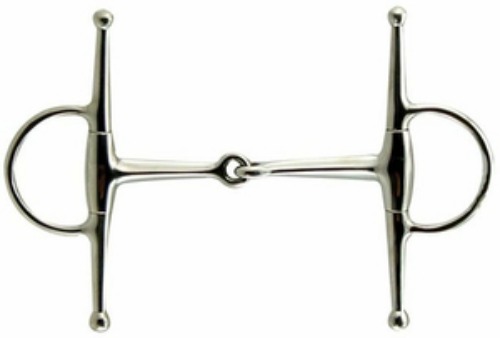
Full cheek snaffle photo courtesy of Mary’s Tack & Feed.
I have been reading all the comments from fellow equestrians and have learned so much in the wake of this event. Here’s a roundup of takeaways which I hope will be valuable to you personally as a rider and help “up” your equestrian safety in and out of the saddle.
1. Full cheek snaffle bits have been the source of many a horse getting caught, injured, and worse.
In my first version of the Avoid This Dangerous Donut in the Saddle blog post, I had not stated Knight’s bit that caught on the iron was a D-ring snaffle. Several of the early commenters asked if it was a full-cheek snaffle and shared tale after tale of those bits being potentially hazardous (especially if used without the keepers).
One of the readers commented her horse’s full cheek snaffle with keepers got caught on the handle of a smaller water bucket and when he realized he was caught, her casualty was a cupcake she had in her hand as she freed him. Other than that, disaster was averted (except for losing out on her dessert).
Another Facebook commenter shared she saw an attempted selfie go awry when a rider’s helmet strap got caught on the end of an “un-keepered” full cheek snaffle. Both horse and selfie-taker were fine in the end.
The saddest story was of a friend of a friend’s horse who had a full-cheek snaffle on, turned to get a fly, the bit got caught on the martingale and the horse flipped over and died of a broken neck.
2. Horses should NOT be allowed to rub their faces on anything with a bridle on.
Fellow blogger Kristen from If the Saddle Fits shared
“Years and years ago, an adult rider I tremendously admired as a kid was standing talking to our trainer after a ride when her jumper rubbed his face on his boots and somehow got caught. They thought later that the rein somehow slipped under one of the boot straps. He panicked and ended up with his back legs slipping, causing momentum to flip him over. They were both seriously injured – he was only pasture sound after that.”
Kristen also shared, “various people I’ve ridden with over the years have always found my insistence that my horses not rub with their bridles on a little weird, but having seen that at 9 or 10 years old from 5 feet away seared it into my brain.”
Duly noted.
3. Several equestrians always carry a pocketknife when they are around horses to cut reins, stirrups, anything that gets caught.
One commenter shared her horse hooked his bottom teeth through his martingale and he ran backwards into a jump which was really scary. This same gal’s father told her the story of a horse who was drinking water and somehow the rein got caught in such a way that the horse couldn’t lift his head and the leather wouldn’t break–the horse drowned. (I’m imagining this was in a creek or river–horrible thought.)
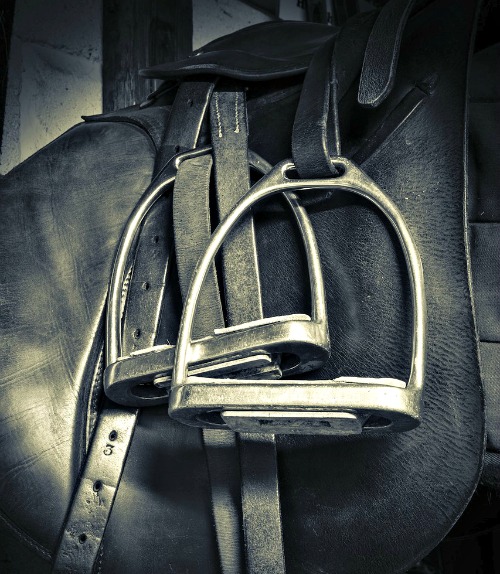
Keep those stirrups away from your horse’s face. And always run them up.
4. Scores of other equestrians had never heard of this type of accident–bit getting caught on stirrup–before either.
Two comments were particularly gratifying: one person said she lets her mare nibble on her toe but after reading this, she’s not going to. Another rider thanked me because she has a new horse she is training to stand still to mount. Once she’s in the saddle she has been giving the mare a treat–she’s not going to do that anymore.
5. A horse can get the bridle/bit hooked like this on a Western saddle too.
Another blogger, Avery from Aha Moments, said she saw this once. I was wondering if the larger size of a Western stirrup made them immune to getting caught. Not so.
6. Trainers yell at students (especially kids) to run their stirrups up the minute they dismount for good reason.
There were stories about horses getting a hoof caught on a stirrup, and other harrowing tales. If you’d like to peruse the Facebook comments first hand, you can see them here.
7. There is such a thing as a one-reined stop.
A few people commented that if Knight had been trained to do this, he would not have panicked and just stood still while his bit was caught on the stirrup. One of the commenters recommended a Clinton Anderson video and so I thought the one-reined stop was something for the cowboy world, but an eventer responded stating that her trainer uses one-reined stops too.
I’m intrigued by this technique, but as my friend Carey pointed out, the idea with the one-reined stop is that once the horse stops, the pressure releases. The pressure did not release on Knight because he was stuck in that position. So who knows if he truly would have stopped and not “donuted”had he been trained to do a one-reined stop.
8. The world-wide community of equestrians is safety-conscious and shared and shared the Dangerous Donut post.
Sharing is caring and bloggers covet traffic, but I honestly don’t want to endure another harrowing event in order to get a viral post. The previous post I had go viral was my Open Letter to the Fitbit CEO From an Equestrian. However, that post does not even compare to the scale of the Dangerous Donut post which garnered 22,000 page views on the first day! (That’s a new record for Saddle Seeks Horse.)
9. Chains on lead ropes/lunge lines can also becoming extremely dangerous.
I had not heard of this type of accident that someone shared in the Facebook comments, “Do not take the chain of your longe line and hook it back to itself and thus creating a metal chain loop for your sweet horse to hook his hoof into when he’s peacefully grazing after a nice bath. Hoof goes through the loop…. another really bad scenario. I added that just in case someone else out there hadn’t considered that. I feel lucky. I also recognize that we don’t know what we don’t know. I don’t beat myself up…. I learn as much as I can from others’ experiences.”
This horsewoman’s attitude rocks! After our accident happened I thought, “If only I had reacted more quickly and jerked his head straight–the bit wouldn’t have caught on the stirrup,” and “If only I had moved my leg backward when I saw his head turn around.”
To Sum Up Equestrian Safety
It’s impossible to prevent every single horse-related accident. So the line about “learn as much as I can from others’ experiences,” hits home. I’m am more informed and can therefore be more safety conscious thanks to the school of hard knocks AND the wonderful community of supportive equestrians.
Thank you for reading! If you liked/learned something from this post, please subscribe to our bi-weekly email (that’s 2x a month).
Your Turn: What safety tips have you learned based on other horse lovers’ experiences? Please share in the comments section. 🙂
Trot along with Knight and me on Instagram, Pinterest, Facebook and Twitter.


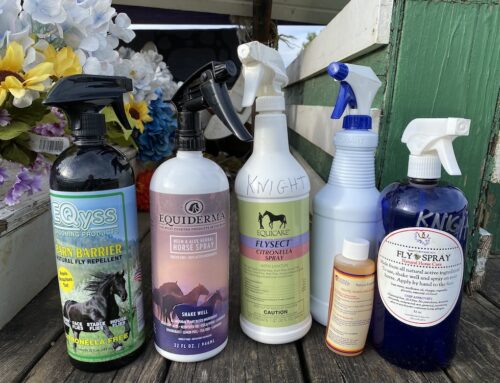
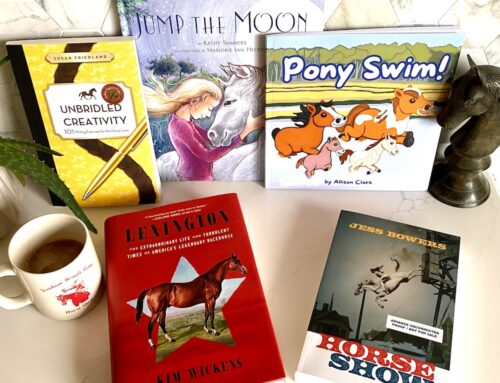
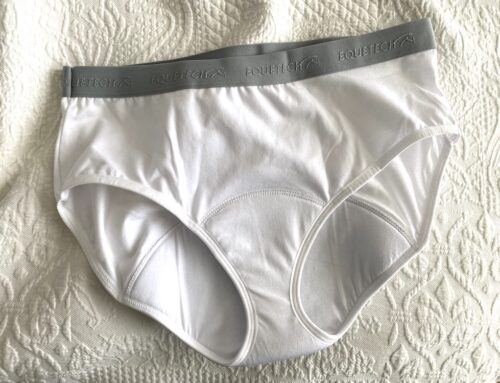
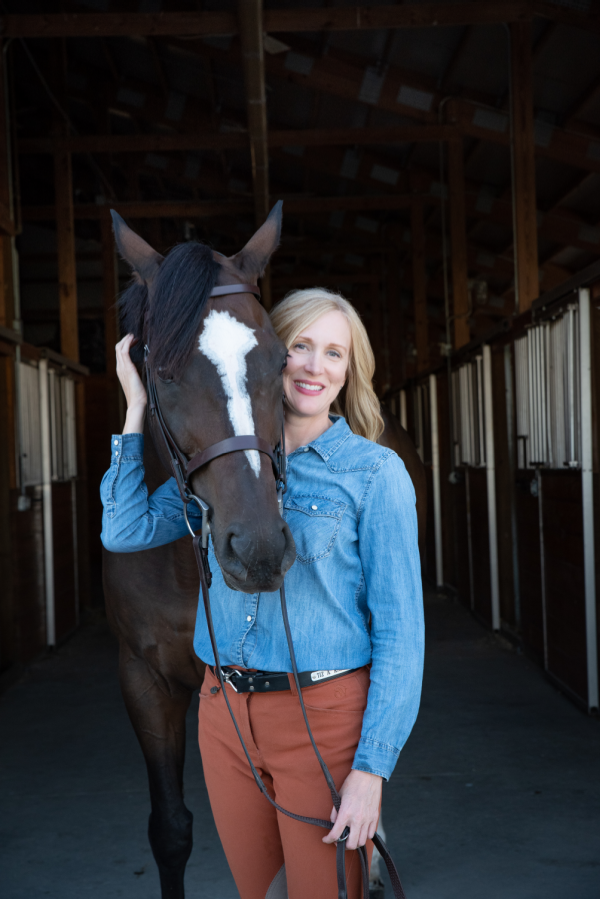

Love it. It is not fun if it is not safe. Many people are too cavalier around horses. Safety education is vital in the basics of horsemanship for everyone around horses.
That’s a great point, Avery. Thanks for reading and I totally agree with you about the cavalier attitude some have. Have a great week!
Where I ride they are very careful about this – it happened once but the horse was able to release quickly. Since then, watch head turning while riding and yes, stirrups up while walking. This is part of my lessons. I’m surprised many don’t know this can happen.